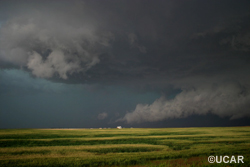Welcome
Summer severe (convective) weather presents many challenges to the forecaster. This self-paced, distance learning course addresses the scientific aspects of a few of those challenges: buoyancy, shear, and their interaction to create various types of summer severe weather phenomena (squall lines, bow echoes, supercells, etc). Summer severe weather is a complex interaction of synoptic and mesoscale forcing. As both mesoscale observations and model resolution improve, the forecaster needs a thorough understanding of this type of high impact weather phenomena in order to react properly during these rapidly evolving situations. These self-paced modules discuss the basic principles of summer severe (convective) weather with the aim of improving the prediction of significant and severe convection.
Course Objectives
The instructional objective for this course is to provide a review of the following core concepts:
- Buoyancy
- Shear
- Interaction of buoyancy and shear
- MCS and other severe convective phenomena including; heavy rain, hail, wind, and tornadoes
Course Goal
The goal of this course is to improve forecasters' prediction of significant and severe convection by:
- Assessing pre-storm environments for (severe) thunderstorm potential
- Identifying, assessing, and forecasting (severe) thunderstorms
Proceed to register on MetEd...
